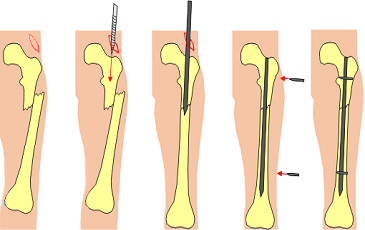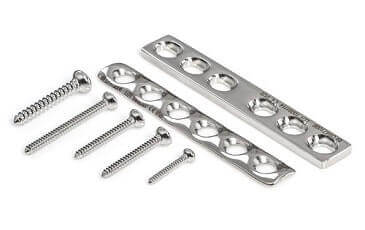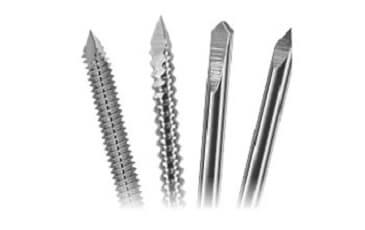Intramedullary nailing
Intramedullary nailing is a surgery done to repair a broken bone to keep it stable. This procedure of fixing the fractures is mostly used for thigh, shin, hip, and upper arm.
Intramedullary nailing is a surgery done to repair a broken bone to keep it stable. This procedure of fixing the fractures is mostly used for thigh, shin, hip, and upper arm.


Bone plates are widely used in internal fixation of the fracture. The plate is fixed on both sides of the fracture to hold the broken pieces together, they are fixed with screws. After healing, plates may be left or removed. This surgery is mostly used for fixation of diaphyseal of the upper extremity and metaphyseal and articular fractures.
Interlocking nail is a unique technology used for many types of fracture configuration including metaphyseal and periarticular fractures. This helps in preventing postoperative instability. These are metallic implants used for traumatic long bone fractures.
K wire also known as Kirschner wires, they are available in different sizes and are used to hold bone fragments together. These are used in operation for temporary fixation. They are used for definite fixation if the fracture fragments are small such as wrist and hand fractures.
To fix up a femur fracture (thighbone) which is the longest and strongest bone in your body, femur nailing operation is done using a metal rod. The metal rod is known as femoral nail also called as an intramedullary nail or interlocking nail.

Tibial shaft fractures are the common long-bone fractures. The standard treatments for diaphyseal tibial fractures are tibial nailing, intramedullary nail (IMN), internal fixation with plate and screws.
Forearm plating is done for forearm fractures that are common orthopedic injuries; plate fixation is the best treatment for displaced forearm shaft fractures in adults.
Amputation is the surgery to remove all or part of a limb. It is performed to treat an injury, disease, tumor, insufficient blood supply, thickening of nerve tissue called neuroma, frostbit, and infection. This surgery is most commonly performed either upper or lower part of the knee.
Wrist fracture may require surgery to hold your bone in place. Your doctor may use implant pins, rods, screws or plates if you have an open fracture, if bone pieces move before they heal, if any damage in the ligaments, nerves or blood vessels.
Elbow plating is a procedure used to treat your broken elbow (olecranon). Open reduction and internal fixation are the types of surgeries used to stabilize and heal the broken bone.
Distal humerus fracture is a crack in the lower end of the upper arm bone. The distal humerus plate has two plate techniques. It creates a girder like structure which provides strength to the fixation- The posterolateral plate acts as a tension band during elbow flexion, and the medial plate provides support to the medial side of the distal humerus.
One of the most difficult and challenging treatments of periarticular fractures is bending the plate to fit into the specific area of the bone. The Periarticular Plating System is pre-contoured to closely follow the shape of the bone and create a fit that requires little or no additional bending, unlike conventional plating systems.
The Distal Femoral Nail DFN is done for the stabilization of fractures of the distal femur. It can also be used for diaphyseal fractures in which a retrograde approach is indicated
The Proximal Tibia Plating System is commonly used to treat nonunions, osteotomies, malunions, osteopenic bone and fractures of the proximal tibia, including simple, comminuted, lateral wedge, depression, medial wedge, periprosthetic and fractures with associated shaft fractures.
The proximal femur plate is used for femur fractures that include fractures of a trochanteric region or with additional fracture of the medial cortex, fractures of the proximal end of the femur, osteotomies of the proximal femur and also used in the fixation of osteopenic bone and nonunions or malunions.
Proximal humeral fractures are the third most common type of fragility fracture for patients over 65 years of age, Most of these proximal humeral fractures are stable, minimally displaced, and can be managed conservatively. Proximal humeral locking plates offer several potential advantages in the treatment of these injuries. These are site-specific, low profile plates designed for fractures and dislocations, osteotomies and nonunions of the proximal humerus.
Unstable elbow is the looseness in the elbow joint that may cause the joint to catch, pop, or slide out of its place during some arm movements.
The elbow joint dislocation occurs due to an injury or trauma that may lead to fracture, injuries to arteries in the arm, and injury to the nerves.
Radial neck fractures are more common in children than in adults. It usually occurs due to a fall on the outstretched hand causing direct longitudinal forces to act on the redial head and neck impacting against the capitellum.
A fractured neck of femur is a serious injury. It usually occur when the top part of the femur is broken, just below the ball and socket.
Trochanteric fractures of the thigh bone, or femur, are not common injuries. The trochanters can be fractured during hip fracture.
Proximal femur fractures are fractures that occur in the femur near the hip region
PFN (proximal femoral nail) is an intramedullary device used in the treatment of unstable pertrochanteric, subtrochanteric and intertrochanteric femoral fractures.
DHS (Dynamic hip screws) is a femoral head-sparing orthopedic device which is used to treat femoral neck fractures. The same is also referred to as a pin and plate.
Cannulated screw fixation of the hip is a widely accepted surgical method for managing the fractures caused in the neck of the femur especially in patients with poor premorbid conditions, minimally displaced fractures and those from a younger age group.
Osteosynthesis is a surgical procedure that is used to join the ends of the fractured bones by metal implants such as metal plates, pins, rods, wires or screws. It is mainly for internal fixation of a fracture.
Ankle fracture is a fracture of one or more bones in the ankle joint. It is mainly caused by a rotational injury of the ankle or due to any fall or accident.
Medial malleolus fracture is a break in the tibia, inside of the lower leg. This fracture often occurs with a fracture of the fibula which is a fracture of the back of the tibia, or due to an injury to the ankle ligaments.
A tibial plafond fracture also known as pilon fracture. It is a type of break that occurs at the bottom of the tibia (shinbone) and involves the ankle joint.
Intraarticular fractures are bone fractures in which the fracture line crosses into the surface of the joint and result in damage of the cartilage.
Joints are those areas where different parts of the skeleton come together. Often joint injuries occur at these intersections. The four types of joint injuries are strains, sprains, fractures, dislocations.
An avulsion fracture occurs when a small piece of bone attached to a tendon or ligament gets pulled away from the main part of the bone. Most of them get healed without any surgical intervention.

Monday - Saturday
10:00Am - 5:00PM
Sunday
9:30Am - 6:00PM